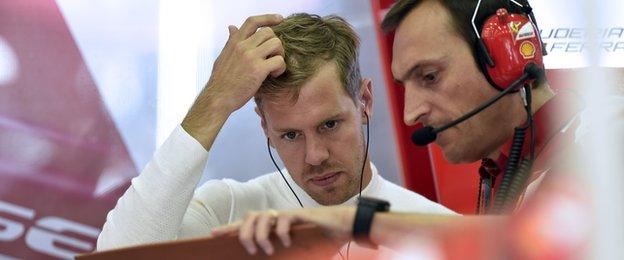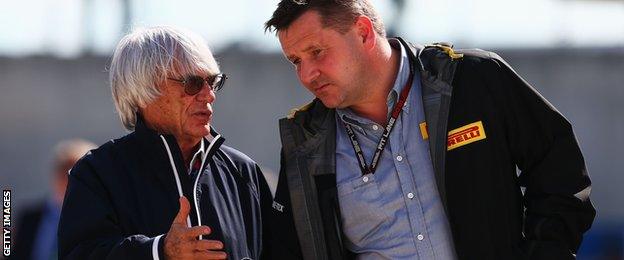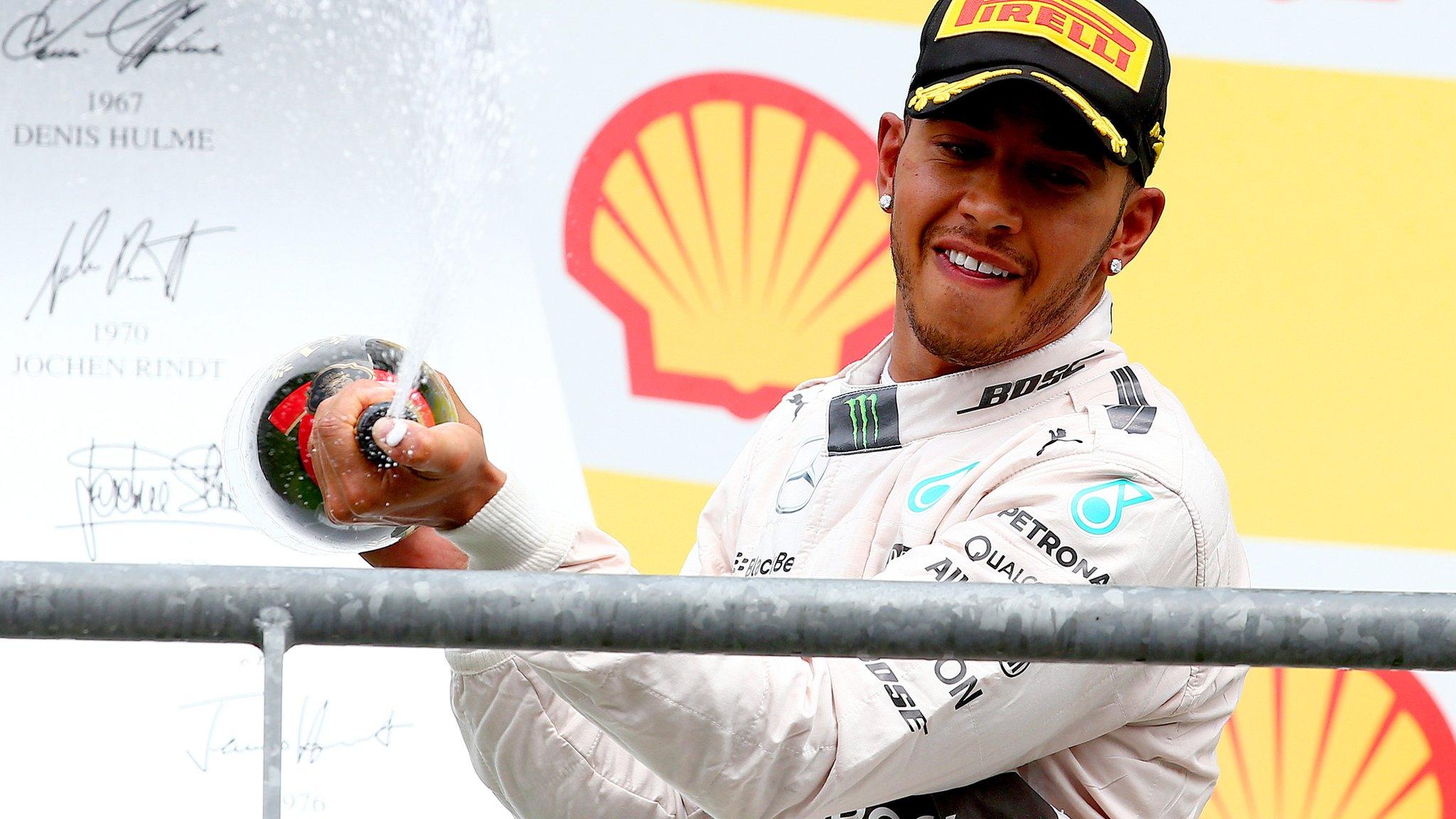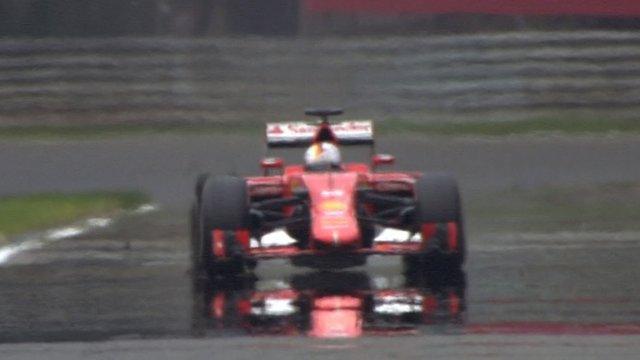Sebastian Vettel not alone in F1 Pirelli concern
- Published
- comments
Sebastian Vettel is a sunny sort of guy for whom a joke and a smile is never very far away. He does not get angry in public very often so when he does you can be sure there is a good reason.
Very rarely has the four-time champion been as transparently furious as he was after the Belgian Grand Prix.
In a tirade littered with expletives, he vented his feelings about the tyre failure at 200mph that cost him a podium position at Spa. And although the loss of 15 valuable points was part of the reason for his heightened emotions, it was very far from being the main one.
Racing drivers get very exercised about tyre failures, for the simple reason that they are so dangerous. Over the Belgian Grand Prix weekend those dangers were plain for all to see.
In Friday practice, Mercedes driver Nico Rosberg suffered a failure of his right rear tyre at 190mph while approaching the flat-out Blanchimont left-hander, one of the most dangerous parts of one of the most demanding tracks on the Formula 1 calendar. Rosberg was, he admitted, "lucky" he somehow did not hit the wall.
The drivers responded to that by raising their concerns about tyre safety with F1 director Charlie Whiting in their briefing later that afternoon.
After extensive investigations, Pirelli announced that they could find no structural problems with Rosberg's tyre or any of their other tyres, and laid the blame squarely on a cut in the tread, although they could not explain what had caused it.
Despite their reassurances, there was widespread concern among drivers and teams during the weekend about whether another problem would resurface. And then came Vettel's failure with two laps of the race to go.
Why is this issue so sensitive?
Tyre failures happen in motor racing and they always will - they are one of the risks of the job. But among the drivers there is a general sense of anxiety about the quality of Pirelli's product.
Part of this is they do not like the fact that the tyres are designed to wear out quickly, so they have to manage them in races more than they would like. But their far more fundamental unease dates back to the 2013 season, when a series of failures climaxed in a catastrophic British Grand Prix, when six tyre failures in one race plunged F1 into crisis.
Pirelli had to make emergency changes to its tyres and since then the issue has been under control. But the drivers' concerns have never really gone away.
The drivers' briefing is held 'in camera', but several of those in the meeting have spoken to this writer about what went on.

Lewis Hamilton was one of the drivers who suffered a tyre failure during the 2013 British Grand Prix
Vettel was one of several leading drivers who questioned Whiting on the issue. Also prominent in the discussion were Lewis Hamilton and Fernando Alonso - the three biggest names in the sport.
Throughout the conversation the drivers' dissatisfaction and concern was plain.
Part of the reason for the drivers' scepticism about whether tyre safety is completely under control is Pirelli's tendency to blame outside factors for failures.
After Silverstone 2013, the company initially blamed the teams, before making changes to the tyres as well as imposing stricter limits on how the teams could operate them.
Generally, the tendency has been to point to cuts in the tyre for failures, whether they be from a driver running over a sharp kerb, or some debris or other external factor, as was the case after Rosberg's failure on Friday.
After the race, Vettel referred to this, in disparaging terms.
Were the drivers' concerns taken seriously in the briefing, he was asked?
"I think they were," he said, "but what is the answer? Same as every time: 'There was a cut, debris, there may be something wrong with the bodywork, the driver went wide'.
"If Nico tells us that he didn't go off the track, he didn't go off the track. Why should he lie to us? Same with me, I didn't go off the track and out of the blue the tyre explodes."
What went wrong?
It is possible that Vettel's tendency to explore the limits of the track to their extremes - which could be seen in Spa as in virtually every other race - played a part in his tyre failure in the race. That may emerge in time.
But Pirelli motorsport director Paul Hembery did not cite this as a possible cause, instead saying that the tyre had come to the end of its wear life.

Sebastian Vettel was furious following the Belgian Grand Prix when his tyre exploded on the penultimate lap
This did not cut much ice with Vettel, who was seen having cross words with Hembery after the race.
"Forty laps, you told us," Vettel said to him - a reference to the recommended maximum tyre life Pirelli had indicated to Ferrari, the fact that the tyre failed after only 28, and the lack of any kind of warning from Pirelli to Ferrari that there might be a problem.
But in the paddock there was scepticism about wear being the cause - because Vettel's lap times were still strong and there had been no sign of the so-called 'cliff', when the tyres suddenly lose grip.
Lotus trackside operations director Alan Permane said he was "surprised" to hear Pirelli had blamed wear.
"You would not have a reliability worry about that," Permane said. "They would generally get to being undriveable before they became unsafe; you would pit stop way before anything like that happened.
"I'd be very surprised if it was a wear-related failure, because they lose performance as you wear them down."
What next?
Vettel was not the only driver to express his concerns about tyre safety after the race. Podium finishers Nico Rosberg and Romain Grosjean did the same.
The drivers are clearly reacting emotionally, but then they have every right to; it's their lives on the line, after all.
For Pirelli, this has come at a very bad time. Not only are tyre failures extremely bad for its image, but its contract runs out at the end of 2016 and the tender process to decide the new supplier is active right now.
Governing body the FIA has approved bids from both Pirelli and Michelin on technical and sporting grounds. The decision is now in the hands of commercial boss Bernie Ecclestone.
The 84-year-old tends to go for the bottom line - money. But he can hardly not take other issues into account.
Ecclestone, a source says, spoke on Sunday night to Pirelli chairman Marco Tronchetti Provera about the events of the Spa weekend.
The FIA, meanwhile, is taking the issue very seriously indeed, as it must do.

F1 boss Bernie Ecclestone talks to Pirelli Motorsport director Paul Hembery
There will be high-level meetings between now and the next race at Monza, also a high-speed track which puts heavy strains on the tyres.
The onus is now very much on Pirelli to provide a convincing answer about what happened to Vettel's car on Sunday, and what it is going to do to ensure as much as possible that it cannot happen again - and convince those involved that is the case.
- Published22 August 2015

- Published23 August 2015

- Published18 August 2015

- Published23 August 2015

- Published20 August 2015

- Published18 December 2015

- Published2 November 2018

- Published26 February 2019
